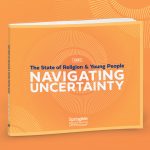Spiritual? Religious? Nothing in Particular?
How Springtide thinks about describing the inner life
There’s a lot of jargon floating around when it comes to the inner lives of young people, especially as new expressions of spirituality and faith emerge. In the complexities of our data alone, we have to hold some of these tensions:
Spiritual but not religious?
Religious but not practicing?
Practicing but not believing?
Believing but not participating?
Atheist, agnostic, or nothing in particular?
We situate our work in the space of religious, human questions—the kind that everyone faces about who and how to be in the world. So what do we mean by religious?
Here’s a quick excerpt from our upcoming report, State of Religion & Young People 2021: Navigating Uncertainty. In it, we spend time defining this term, including our sociological interest in it:
For Springtide, the term religious is not a reference to a particular creed, code, or system, but rather a term that captures and categorizes a wide array of diverse impulses, questions, and connections. These are the impulses that inspire young people to pursue community, identity, meaning, and various practices. And we recognize that these impulses are increasingly finding expression in ways that may not seem overtly religious because they are not connected directly to a specific tradition or institution. Instead, the desire for meaning may show up in careers, club sports, or creative hobbies. Young people find outlets for justice, faith, or purpose in politics, volunteering, nature, and close relationships. While we see the value in any activity that promotes the flourishing of young people, we also recognize the unique value traditional religion often can and does offer. From a sociological standpoint (as opposed to a theological one), we see the way religions, across creed and culture, can offer frames for living well, with careful consideration for congruence between the inner and outer life. We acknowledge the historical significance of religion for navigating times of uncertainty as well as questions of meaning, identity, and community, and it is from this starting point that we begin thinking about the ways young people are (or are not) engaging religion today.
Other organizations, institutes, scholars, or laypeople may define religiosity or spirituality differently. If you work in or study these fields—or even if you’re just interested in these kinds of conversations—how do you parse the language? Share your thoughts with us on social, or email us at info@springtideresearch.org.





